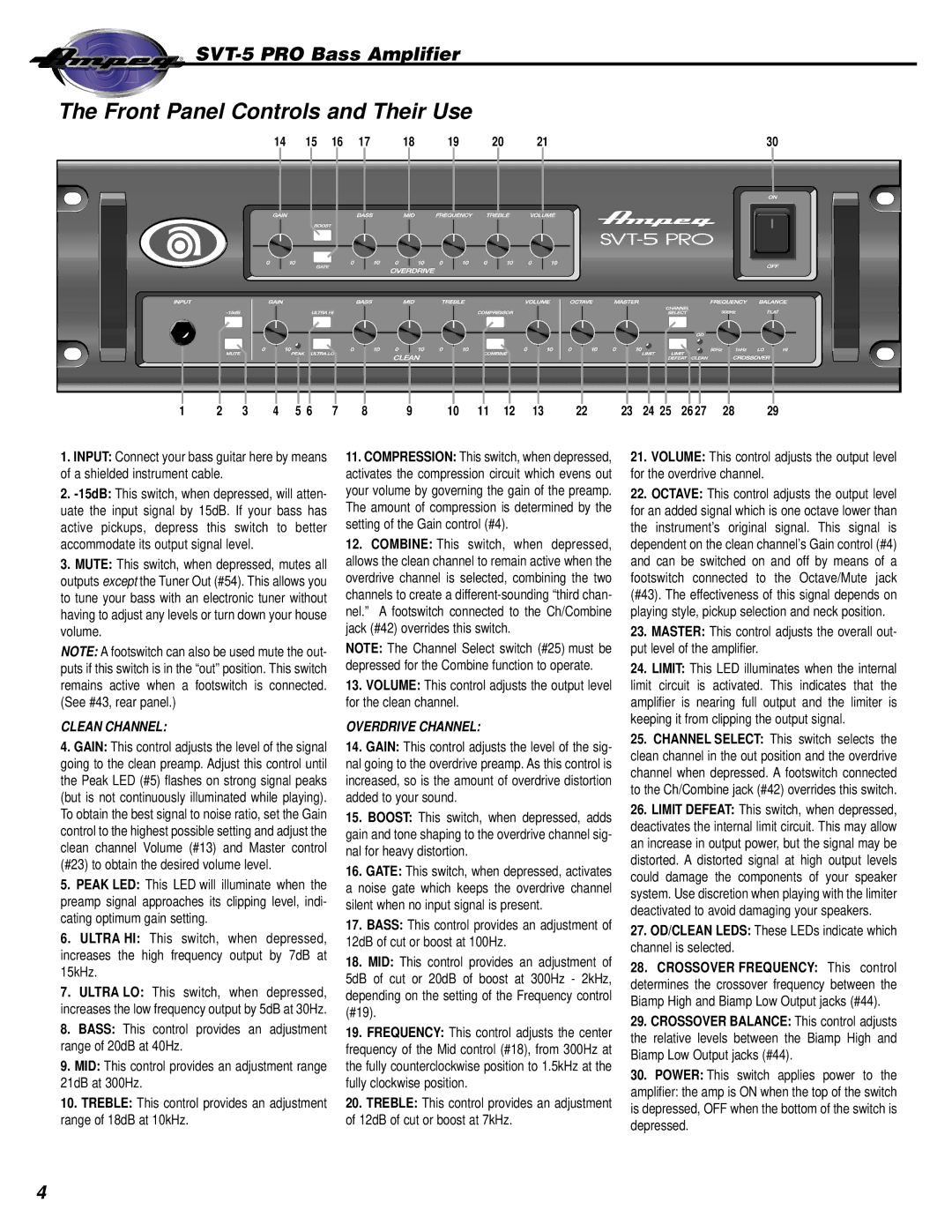
SVT-5 PRO Bass Amplifier
The Front Panel Controls and Their Use
|
|
| 14 | 15 | 16 | 17 | 18 | 19 |
| 20 | 21 |
|
|
|
|
| 30 |
1 | 2 | 3 | 4 | 5 6 | 7 | 8 | 9 | 10 | 11 | 12 | 13 | 22 | 23 | 24 25 | 26 27 | 28 | 29 |
1.INPUT: Connect your bass guitar here by means of a shielded instrument cable.
2.
3.MUTE: This switch, when depressed, mutes all outputs except the Tuner Out (#54). This allows you to tune your bass with an electronic tuner without having to adjust any levels or turn down your house volume.
NOTE: A footswitch can also be used mute the out- puts if this switch is in the “out” position. This switch remains active when a footswitch is connected. (See #43, rear panel.)
CLEAN CHANNEL:
4.GAIN: This control adjusts the level of the signal going to the clean preamp. Adjust this control until the Peak LED (#5) flashes on strong signal peaks (but is not continuously illuminated while playing). To obtain the best signal to noise ratio, set the Gain control to the highest possible setting and adjust the clean channel Volume (#13) and Master control (#23) to obtain the desired volume level.
5.PEAK LED: This LED will illuminate when the preamp signal approaches its clipping level, indi- cating optimum gain setting.
6.ULTRA HI: This switch, when depressed, increases the high frequency output by 7dB at 15kHz.
7.ULTRA LO: This switch, when depressed, increases the low frequency output by 5dB at 30Hz.
8.BASS: This control provides an adjustment range of 20dB at 40Hz.
9.MID: This control provides an adjustment range 21dB at 300Hz.
10.TREBLE: This control provides an adjustment range of 18dB at 10kHz.
11.COMPRESSION: This switch, when depressed, activates the compression circuit which evens out your volume by governing the gain of the preamp. The amount of compression is determined by the setting of the Gain control (#4).
12.COMBINE: This switch, when depressed, allows the clean channel to remain active when the overdrive channel is selected, combining the two channels to create a
NOTE: The Channel Select switch (#25) must be depressed for the Combine function to operate.
13.VOLUME: This control adjusts the output level for the clean channel.
OVERDRIVE CHANNEL:
14.GAIN: This control adjusts the level of the sig- nal going to the overdrive preamp. As this control is increased, so is the amount of overdrive distortion added to your sound.
15.BOOST: This switch, when depressed, adds gain and tone shaping to the overdrive channel sig- nal for heavy distortion.
16.GATE: This switch, when depressed, activates a noise gate which keeps the overdrive channel silent when no input signal is present.
17.BASS: This control provides an adjustment of 12dB of cut or boost at 100Hz.
18.MID: This control provides an adjustment of 5dB of cut or 20dB of boost at 300Hz - 2kHz, depending on the setting of the Frequency control (#19).
19.FREQUENCY: This control adjusts the center frequency of the Mid control (#18), from 300Hz at the fully counterclockwise position to 1.5kHz at the fully clockwise position.
20.TREBLE: This control provides an adjustment of 12dB of cut or boost at 7kHz.
21.VOLUME: This control adjusts the output level for the overdrive channel.
22.OCTAVE: This control adjusts the output level for an added signal which is one octave lower than the instrument’s original signal. This signal is dependent on the clean channel’s Gain control (#4) and can be switched on and off by means of a footswitch connected to the Octave/Mute jack (#43). The effectiveness of this signal depends on playing style, pickup selection and neck position.
23.MASTER: This control adjusts the overall out- put level of the amplifier.
24.LIMIT: This LED illuminates when the internal limit circuit is activated. This indicates that the amplifier is nearing full output and the limiter is keeping it from clipping the output signal.
25.CHANNEL SELECT: This switch selects the clean channel in the out position and the overdrive channel when depressed. A footswitch connected to the Ch/Combine jack (#42) overrides this switch.
26.LIMIT DEFEAT: This switch, when depressed, deactivates the internal limit circuit. This may allow an increase in output power, but the signal may be distorted. A distorted signal at high output levels could damage the components of your speaker system. Use discretion when playing with the limiter deactivated to avoid damaging your speakers.
27.OD/CLEAN LEDS: These LEDs indicate which channel is selected.
28.CROSSOVER FREQUENCY: This control determines the crossover frequency between the Biamp High and Biamp Low Output jacks (#44).
29.CROSSOVER BALANCE: This control adjusts the relative levels between the Biamp High and Biamp Low Output jacks (#44).
30.POWER: This switch applies power to the amplifier: the amp is ON when the top of the switch is depressed, OFF when the bottom of the switch is depressed.
4
